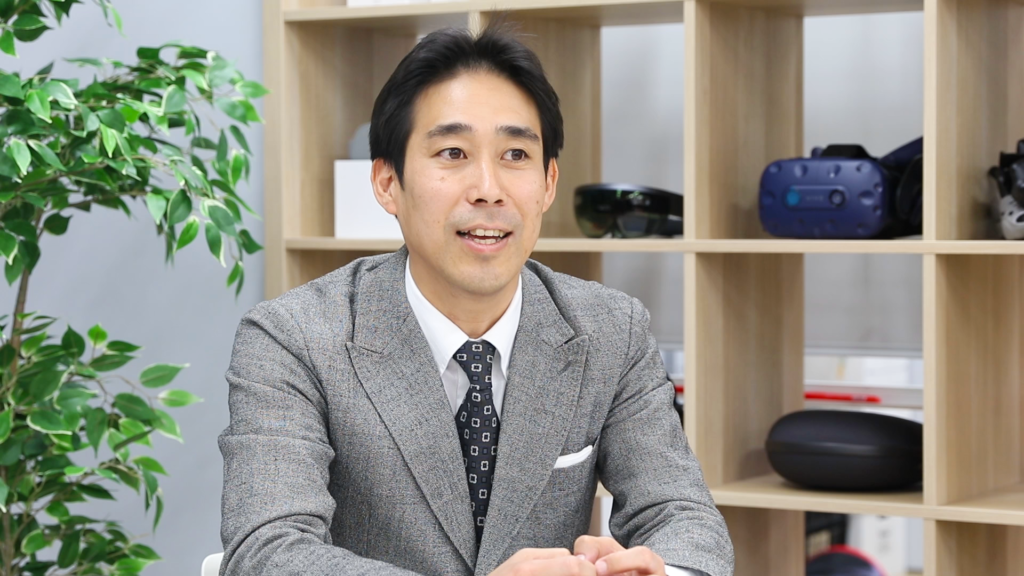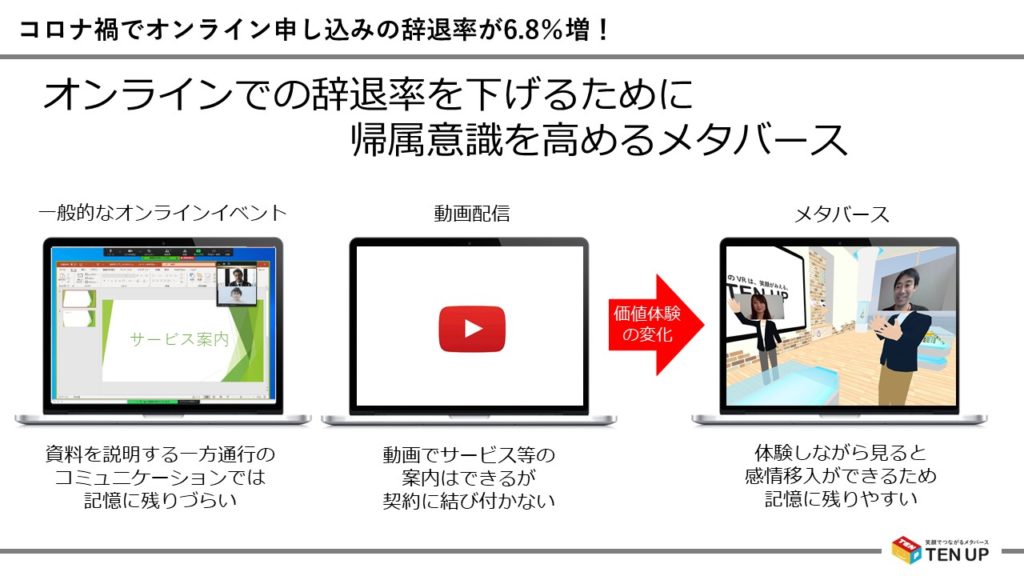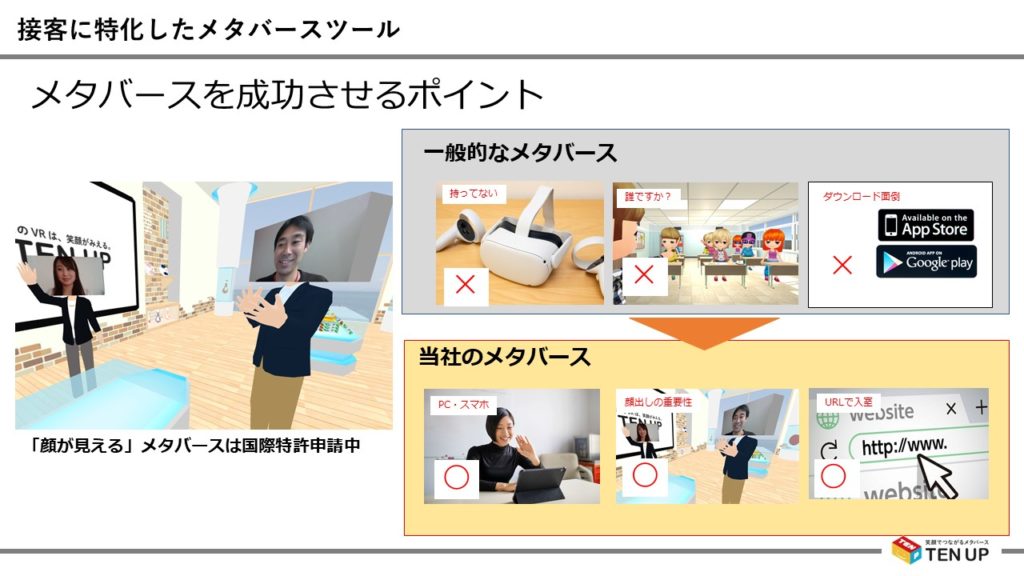Mr.Tatefumi Kanaya, CEO of TEN UP Inc.
It is a common belief that metaverse application is limited given the need for things like special goggles and other requirements. TEN UP Inc. has made thorough efforts to realize a metaverse space that people can easily use. It has built a virtual space that allows users to enter via a single click without VR goggles and that uses real videos of users, instead of avatars, to display their faces so that they can have much more human communication. Mr. Tatefumi Kanaya, the CEO of the company, talked about the great potential of its metaverse.
―TEN UP received the special prize at the Business Acceleration Program 2017 hosted by ICF. The award-winning business idea was the prototype for your current business model, right?

That’s right. At that time, we were saying that it would be great if students, just by watching VR videos, could improve their deviation scores and attend the University of Tokyo (one of the top universities in Japan), which was a kind of dream. We were still in an early planning stage five years ago. Time sure flies! We have been conducting a lot of research since then.
―I heard that many companies have supported your idea from the beginning.
We were able to gain the support of major companies such as DENTSU INC. and Kirin Holdings Company, Limited from an early stage and have conducted many demonstration experiments. To turn children’s learning into something fun yet highly efficient through the metaverse, we have tried a variety of things, including providing school tours and work experiences.
―I’ve also heard that you’ve already achieved great results.
Yes. In recent years, the effect of classes in our metaverse space have become clearer and clearer. For example, students who learned in the classes have graduated Kaisei Senior High School (one of the top senior high schools in Japan) or entered competitive universities. Students themselves also appreciate the classes, saying that they are more fun than online classes via a web conferencing system.
All sorts of learning can be more productive if students learn through experience, so it’s very effective to learn in a 3D space. Our metaverse is also appreciated for the fact that it can be implemented at low cost.
One thing we would really like everyone to know is that the metaverse definitely works, it’s not just a fun-looking experience.

―It “definitely works.” I see. By the way, the company name is “TEN UP,” and your website now says Trust, Engage, Notice, and Up. If I remember correctly, the original meaning of the name was different, right?
Yes, it was! TEN UP originally means “up your score” (laughs)! (“Score” is “ten” in Japanese.) The company name really refers to the effect itself. We have been offering simulations in the metaverse to improve students’ academic skills, and they have received better scores. We now expect that our metaverse can be used in various industries other than education. For these two years, we have been conducting new research to apply it to business fields.
―I think the metaverse and VR technology is an area of great interest right now. Are you feeling any response?
Statistics show that about 40% of 1000 companies are very interested and half of those interested want to take some action within one year. It’s a quite hot area, but the reality is that they can’t put it into practice right away.
―Why can’t they put it into practice?
Companies with none of the necessary equipment on hand, like VR goggles, usually don’t even have the first clue as to what to do, being at a loss on what to do first. Although there are many metaverse platforms (operating environments) available, they don’t know which one to choose. Even when arriving at the payment step, they find that they don’t know how to utilize the metaverse. These are typical reasons why metaverse has not widely spread.
―So, you’ve put some ideas in place to solve them.
First, we have made it easier for people to try and get started without the need for VR goggles and other special equipment or environments.
In addition, we have allowed people to easily enter from the URL of the website they use without having to think about which platform is most appropriate.
The last problem, how to utilize the metaverse, is quite difficult, but we try to help people realize the effectiveness of the metaverse by jointly considering how to use it using various examples and by studying past examples.
Moreover, most metaverses use animated avatars as the representatives of users, which doesn’t really tell them who is who. We have allowed users to display their real faces through a web camera. This has made it easier not only to identify individuals, but also to communicate the level of understanding and satisfaction by facial expressions, greatly expanding our target industries.

―I heard that you’ve already achieved great results in construction, real estate, and other industries.
While it normally takes 20 years for the construction industry to train a site manager, our technology has successfully shortened the training period to just one year. Since it usually takes more than 10 years even for a qualified first-class architect, this speed is amazing. We ask construction sites across Japan to send us 360-degree images of construction mistakes and daily considerations to provide novice site managers with 3D experiences through our metaverse.
This has made it possible to acquire knowledge super quickly that previously could only be acquired through direct and physical experience. In the construction industry, the number of site managers is associated with the number of construction sites, so training them is a huge issue. We have provided a method that pushes us one step closer to resolving the issue entirely.
―In the real estate industry, you’ve also solved problems directly related to contracts, too, right?
The real estate industry uses our metaverse for online customer service. Customers can take their time to see 360-degree images of real estates and can even enter, as avatars, the living environment to see the smaller details. They can also see the cityscape without visiting the physical site. This time saving allows customers to take short virtual tours on weekdays.
Our metaverse helps salespeople understand what customers are interested in, so they can easily apply that information to additional sales techniques by saying things like, for example, “Please come with your children next time!” Real tours on Saturdays and Sundays are also very efficiently conducted because the “points to see” are narrowed down in advance. It is now said that the contract rate is higher when customers take both metaverse and real tours than when they take only real tours. So, yes, I’d say this is good application (laughs).
―Yes, it is. I also heard that your metaverse has been remarkably effective in the hiring of new graduates and for online stores.
In terms of new graduate hiring, our system seems to be a perfect fit with the needs of third-year college students who are seeking employment. Our metaverse is used in various ways. For example, trading companies use it to show overseas branches realistically in 3D images, and factories use it to show the factory itself and even equipment used there to attract science students.
The number of visits to a recruitment website on the first day was a whopping 14.3 times higher than in the previous year and that on the second and subsequent days remained higher year-over-year. Since our metaverse provides simulated experiences that allows students to imagine how they will work, the browsing time also increased 16-fold compared to the previous year. These results seem to have led to many applications.
We have also produced good results for online stores: increased visits, increased dwell time, and even reduced costs.
Let’s take an online store selling eels as an example. Many people may imagine an online shopping site that has eel images and a cart icon. Our metaverse allows the store to offer visitors appetizing and enjoyable videos based on 360-degree images of real landscapes of Hamamatsu (famous as a place of eel production), catch scenes, and cooking sites. Most of all, a metaverse website can be built at low cost, which course of is also attractive.
―I expect that metaverse will be used for various other businesses in the future.
We also see great potential in the application of this system to a bunch of other businesses. For example, elderly people with restricted physical abilities will be able to play energetically with their grandchildren in a metaverse space. I think the metaverse has various possible uses that are unique to a 3D space and that can’t be realized in Zoom or other 2D spaces.
We hope that we will be able to exchange views with you, readers of this article who are interested in our business. Upon request, we would be very excited to show you around our metaverse space.
| Company name::TEN UP Inc. |
| Founded:October 2016 |
| Number of employees:10 |
| Main Businesses:Planning, developing, and operating futuristic services URL:https://www.10up.co.jp |
This article is part of a series of articles introducing venture companies working together as ICF members to resolve societal issues.





